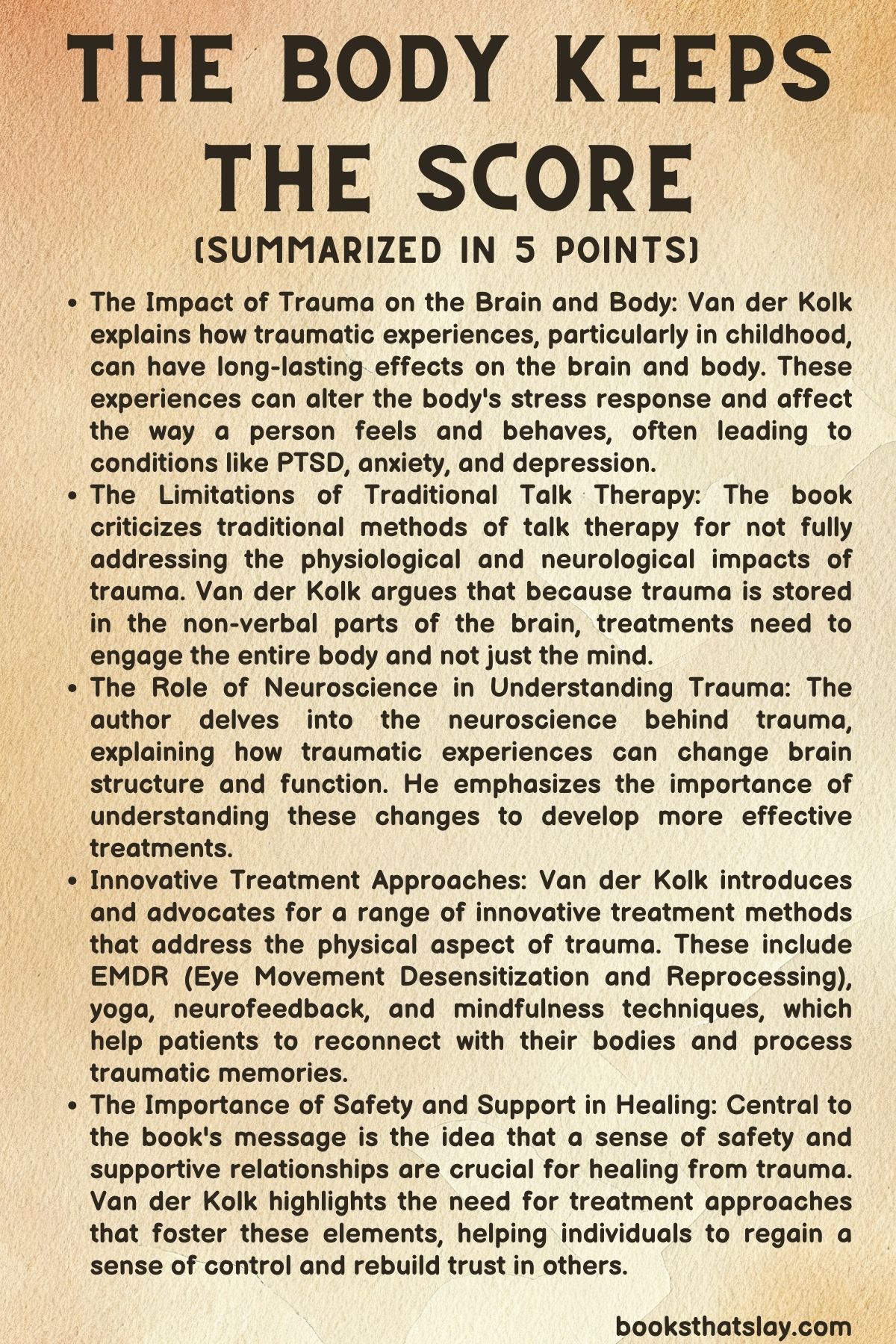The Body Keeps the Score Summary and Key Lessons
“The Body Keeps the Score: Brain, Mind, and Body in the Healing of Trauma” is a seminal work by Dr. Bessel van der Kolk, an internationally recognized leader in the field of psychological trauma.
Published in 2014, the book explores the complex ways that trauma can affect individuals and provides innovative solutions for recovery.
The Body Keeps the Score Summary
Van der Kolk begins by providing an overview of trauma, explaining that it is not just about the events that occur but also about the imprint left by those experiences on the mind, brain, and body.
This imprint has profound effects on the individual’s feelings, thoughts, and physical health.
The book is divided into five parts:
1. Part One: The Rediscovery of Trauma
In the first part, van der Kolk describes the history of trauma studies, his own experiences in the field, and how societal attitudes toward trauma have shifted over time.
He outlines the biological basis of trauma, emphasizing that trauma results in actual physiological changes, including a recalibration of the brain’s alarm system, an increase in stress hormone activity, and alterations in the system that filters relevant information from irrelevant.
2. Part Two: This is Your Brain on Trauma
In part two, van der Kolk delves into the neuroscience of trauma, explaining how traumatic experiences impact different areas of the brain.
He introduces the concept of neuroplasticity and how the brain’s structure and function can be shaped by traumatic experiences. He also touches upon how trauma disrupts the body’s ability to recognize safety and danger.
3. Part Three: The Minds of Children
In the third part, the author focuses on developmental trauma and its impacts on children. Trauma can significantly interfere with the ability to grow and learn, leading to difficulties in school, relationships, and later life.
The emphasis is placed on the importance of secure attachments, stable environments, and therapeutic interventions in helping children overcome the impacts of trauma.
4. Part Four: The Imprint of Trauma
In this section, van der Kolk explores how trauma affects individuals’ emotions, thoughts, and behaviors.
He provides insight into the complex symptoms of trauma, including hyperarousal, intrusion, constriction, and changes in the perception of self and others.
Additionally, he discusses how trauma can lead to the development of disorders such as PTSD, depression, and dissociative disorders.
5. Part Five: Paths to Recovery
In the final section, van der Kolk presents various methods for treating trauma.
He discusses traditional approaches like cognitive behavioral therapy, but also delves into alternative methods such as eye movement desensitization and reprocessing (EMDR), yoga, mindfulness, and neurofeedback.
He emphasizes the importance of finding approaches that help integrate traumatic memories, restore the balance of the nervous system, and reestablish a sense of safety and self-control in survivors.

Key Lessons
1. The Impact of Trauma is Far-Reaching and Multi-Dimensional
The book opens our eyes to the complex and pervasive impact of trauma, making it clear that it is not confined to mental and emotional distress alone.
Trauma affects the brain’s wiring and can manifest in physical symptoms. For instance, a person with unresolved trauma may experience chronic pain, gastrointestinal issues, or a heightened state of alertness, even when there is no immediate threat.
This lesson underscores the importance of adopting an integrated approach in treating trauma, one that takes into consideration not just the psychological but also the physical ramifications.
2. Trauma Can Alter Perception and Memory
Van der Kolk details how trauma can dramatically alter a person’s memory and perception.
Traumatic experiences, particularly in childhood, can disrupt the normal development of brain structures responsible for cognition and emotional regulation, leading to memory gaps, distortions, and fragmentation.
This understanding highlights the importance of treatments that focus on memory integration and reconstruction.
3. The Importance of the Body in Healing Trauma
The title itself underscores one of the key lessons of the book, that the ‘body keeps the score’. This means that our bodies remember trauma, even when our conscious minds may not.
Therapies that involve the body, such as yoga, meditation, theater, and even neurofeedback, can be especially effective in healing trauma.
The author provides numerous examples where body-based treatments help trauma survivors to reconnect with their bodies, regain control, and reduce trauma-related symptoms.
4. The Necessity for Personalized Trauma Treatment
The Body Keeps the Score emphasizes that there is no “one size fits all” approach to healing from trauma. The author suggests that different people respond differently to various types of therapies.
For example, one person might find healing through talk therapy, while another might respond better to a body-focused approach like yoga or dance.
This calls for a personalized and holistic approach to trauma treatment that respects the unique needs, preferences, and healing timelines of individuals.
Final Thoughts
Overall, van der Kolk’s work is a vital read for anyone seeking to understand trauma and its effects more deeply. It offers both a conceptual understanding of the complexities of trauma and practical applications for healing.